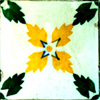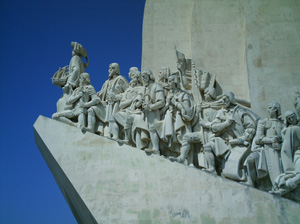 The Discoveries Monument was built as a celebration of Portuguese sea-faring history. The names of great explorers still reverberate around Portugal and their courage to brave uncharted waters and sail to unknown destinations are an inspiration. It was these who took Portugal from being a small country to one that discovered and colonised many lands. Originally conceived and built in the 1940’s by architect Cottinelli Telmo and sculptor Leopoldo de Almeida, the monument was rebuilt in 1960 to commemorate the 500th anniversary of the death of Henry the Navigator. Prince Henry was the son of King John 1st of Portugal and it is his image that is captured at the head of the monument carrying a 3-sailed ship like those Portugal used of old.
The Discoveries Monument was built as a celebration of Portuguese sea-faring history. The names of great explorers still reverberate around Portugal and their courage to brave uncharted waters and sail to unknown destinations are an inspiration. It was these who took Portugal from being a small country to one that discovered and colonised many lands. Originally conceived and built in the 1940’s by architect Cottinelli Telmo and sculptor Leopoldo de Almeida, the monument was rebuilt in 1960 to commemorate the 500th anniversary of the death of Henry the Navigator. Prince Henry was the son of King John 1st of Portugal and it is his image that is captured at the head of the monument carrying a 3-sailed ship like those Portugal used of old.
There are 30 figures in all on the monument – I have yet to discover the names of all of them but here are some (this list is taken directly from Wikipedia) :-
Henry the Navigator (sponsor of the Age of Discovery)
Vasco da Gama (discoverer of the sea route to India)
Pedro Ãlvares Cabral (discoverer of Brazil)
Ferdinand Magellan (first to circumnavigate the globe)
Diogo Cao (first to arrive to the Congo river)
Bartolomeu Dias (first to cross the Cape of Good Hope)
Afonso de Albuquerque (second viceroy of Portuguese India)
Luís de Camães (renaissance poet who celebrated the navigations in the epic Lusiads)
King Manuel I (ruler on the Age of Discovery)
Pedro Nunes (16th century mathematician)
Nuno Gonçalves (15th century painter)
One of my projects will be to discover who’s who on the monument! Luís de Camães can be recognised because he carries a book of the Lusiads and King Manuel I carries an armillary sphere.
The whole monument is shaped like a ship’s prow and evokes a sense of wonder as it stares majestically out across the Tagus and on to the Atlantic Ocean. At 52 metres high it is imposing and inspiring. I found myself quite hypnotised by it; the calm yet resolute face of Henry, the intricate detail found in the faces of these great men. It is strange that a statue can have such stillness yet at the same time provoke such a sense of movement. I found it very compelling. And all the while I stood, the breeze from the sea blew over me just as it would have done all those centuries ago.
Inside the monument is a small area displaying exhibitions and a slideshow entitled ‘The Lisbon Experience’. Unfortunately we missed this when we were there but I’ve heard it’s well worth seeing. You can get a taste of it at The Lisbon Experience website where you’ll also find an interesting slideshow (The Lisbon Experience website has now disappeared but there are short films on the Discoveries Monument website). The times and prices of the shows at the Monument can all be found here as well.
Do take the elevator to the top of the momument for a fantastic view across the sea and Belém and for the best view possible of the stunning mosaic at the base of the Monument.
How to Get There The Discoveries Monument is in the Belém district of Lisbon. You will find plenty of other attractions to visit in this area so it’s well worth planning to be there for the day to take in the other sites.
Getting to Belém is very easy. I would recommend the tram as it would be one heck of a long walk otherwise! If memory serves me correctly it took about 15 minutes on the modern superfast Tram 15 which is more like a mini train. You can catch Tram 15 from Praça da Figueira.
The timetable for the number 15 tram is here
Running times back into central Lisbon are here
Once you get off the tram, walk in the same direction as it’s travelling towards the gardens and the sea which are on the left hand side. As a quick note, remember to glance to your right to make sure you know where the Antiga Confeitaria de Belem is because you’ll be wanting to buy a custard tart (Pasteis de Nata) from there at sometime during your visit to Belém! Cut through the gardens which are very pretty although you may be accosted by streams of ladies who want you to buy a scarf from them as we were (!) and make for the sea. You can’t miss the monument. We went on a late morning one Sunday and the weather was glorious. Consequently the area was packed with tourists. Next time I visit I may try going early in the morning on a weekday to see if I can avoid the crowds a little.
If you’re planning a trip to Lisbon I would put the Discoveries Monument on your to do list. It encapsulates an integral part of Portuguese history.
References and Bibliography
Wikipedia
Carris.pt (Main public transport operator)
The Discoveries Monument


4 comments for “The Discoveries Monument – Padrao dos Descobrimentos”